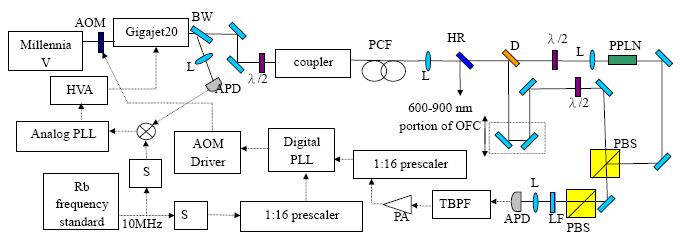
Optical Frequency Comb (OFC)
| NTHU
Optical Frequency Comb
The setup of NTHU optical frequency comb. Components
shown are AOM:Acousto-optic modulator , BW:Brewster window, PCF:photonic
crystal fiber, L: lens, HR:600~900 nm high reflection mirror, D:532
nm dichroic mirror, PPLN:periodically-poled lithium niobate, PBS:polarizing
beam splitter, LF:532 nm line filter, APD:avalanched photodiode, TBPF:tunable
bandpass filter, LNA:low noise amplifier, PLL:phase-locked loop, S:synthesizer,
HVA:high voltage amplifier. The solid-lines represent optical paths,
the dot-lines represent electrical paths. |
| Principle
The upper diagram is pulses from mode-locked lasers in time domain. The lower diagram is the pulses in frequency domain. The spectral coverage and cavity modes are represented by colorful and broken blue lines respectively. The offset frequency δ is caused by the relative phase φ between envelope and carrier.
The f-2f self-referencing scheme for measuring the offset frequency. Kerr-lens mode-locking allows the generation of light pulses whose durations are as short as a few femtoseconds. Our laser is a Kerr-lens mode-locked Ti:sapphire laser (Gigaoptics, Gigajet20). The repetition frequency is about 1 GHz and the pulse width is about 35 fs. The output spectrum is centered at 810 nm with a bandwidth of 40 nm. The output power is larger than 650 mW under 5 W 532 nm pumping. The major output beam is coupled into a 1 m long photonic crystal fiber (PCF, Crystal Fibre A/S, NL-PM-750). This PCF is recommended by the manufacturer for supercontinuum generation excited by mode-locked Ti:sapphire laser. |
Application in High Precision Spectroscopy Our measurement result with reference to Mazzoti’s
result (solid line). The error bar is the standard deviation of each
measurement. The uncertainty of our result is about 2.5 kHz. The difference
with respect to Mazzoti’s result is about 8.5 kHz which is probably
caused by the offsets in the frequency locking of the two lasers or
the shift due to different CO2 pressures in our work and their work.
One of the beat signal measurement. Gate time is set
to 0.1 second and measure 2000 points. The mean frequency is 773.213
MHz, standard deviation is 13.89 kHz. |

